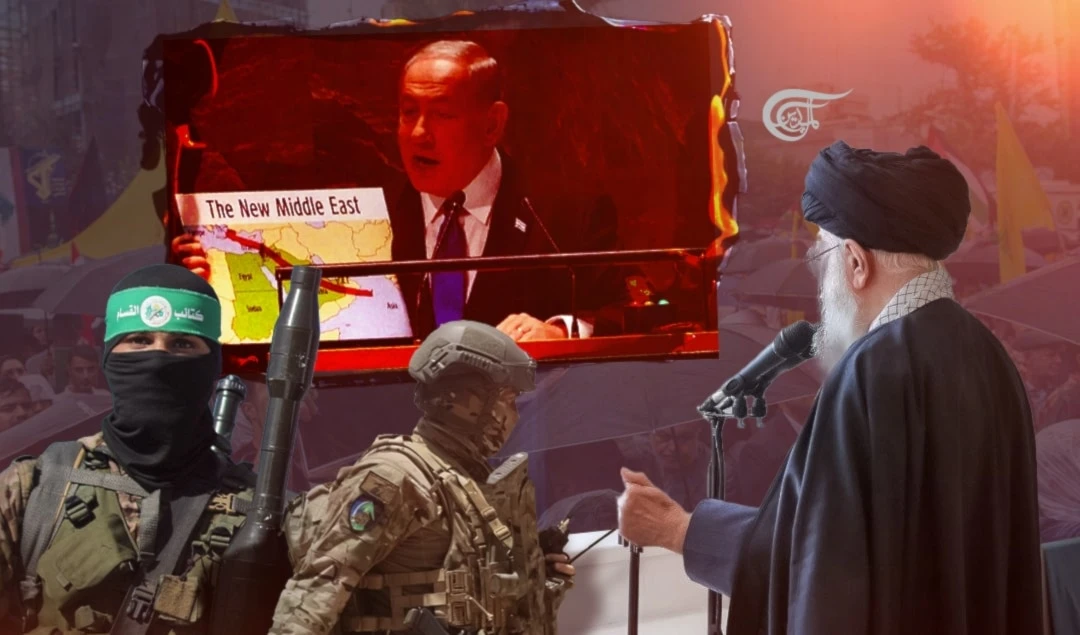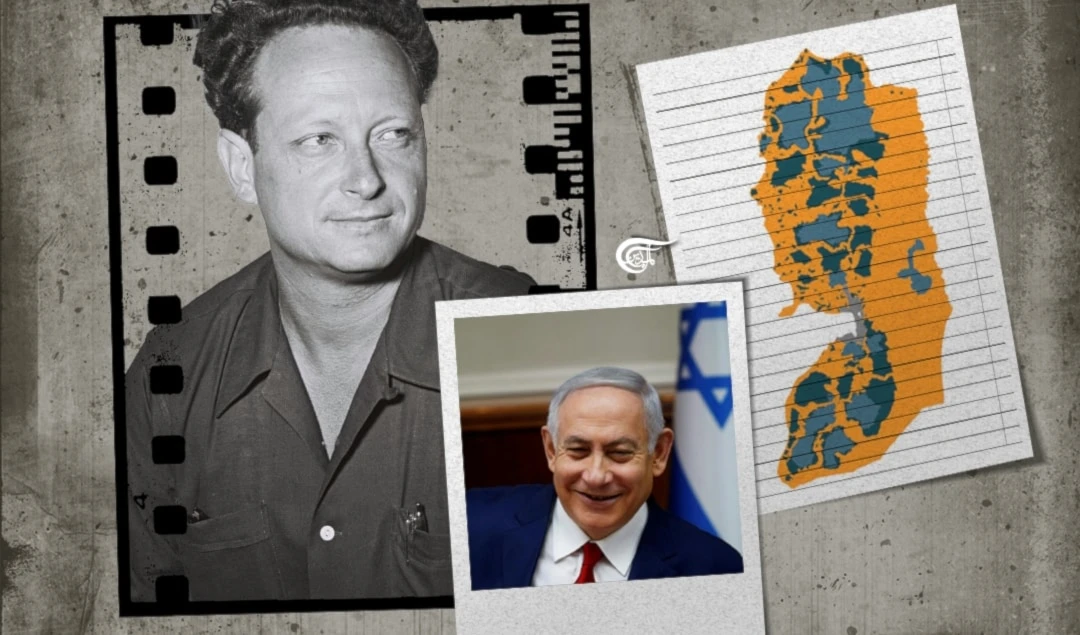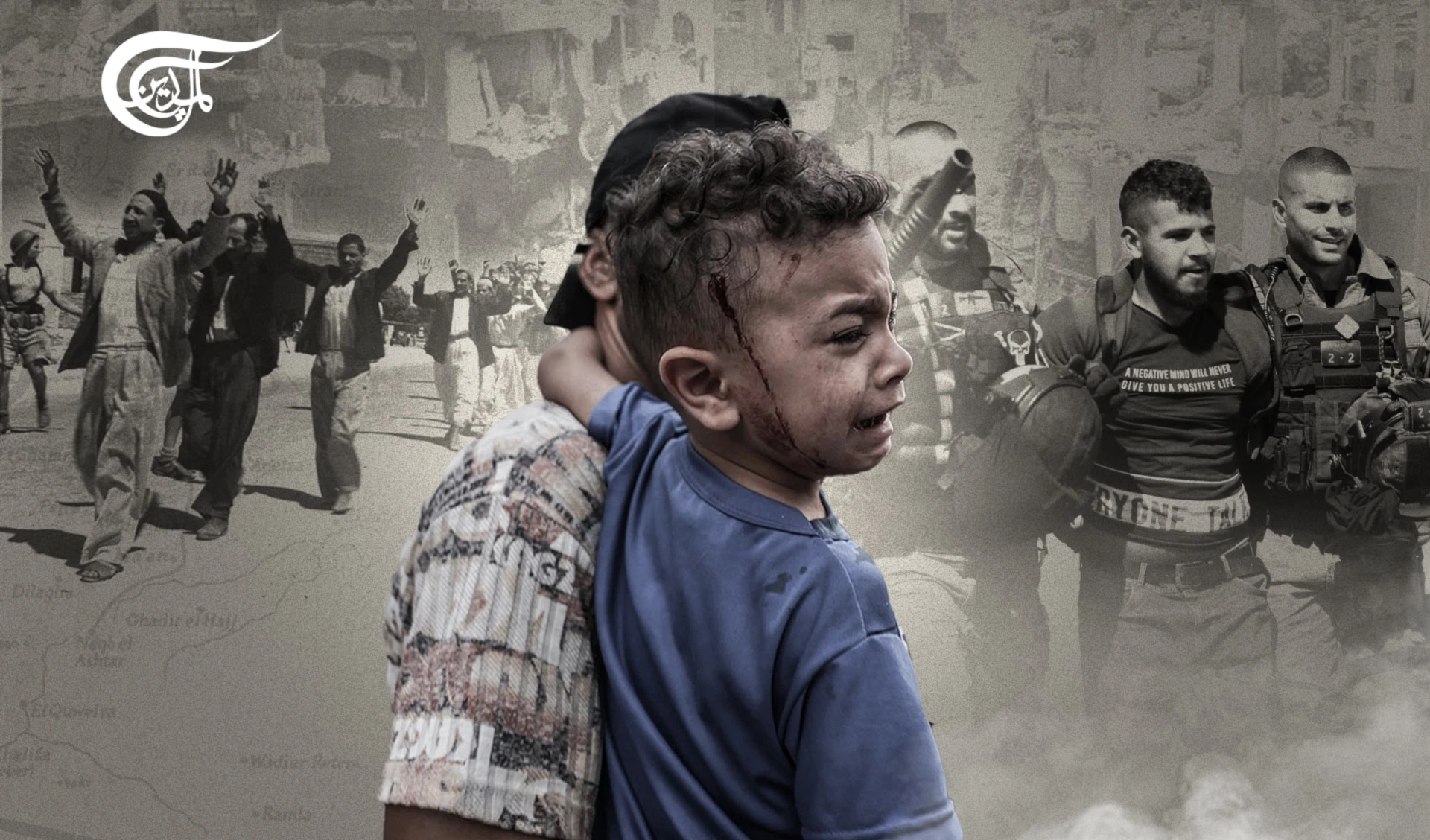Gaza metamorphosis: From Stone Intifada to war of genocide on Palestinians
Extracts from the journalistic reports of Prof. Dr Makram Khoury-Machool which announced the outbreak of the first Palestinian Intifada show that history neither started then nor now.
-

Watching on the screen, and being in constant touch with various medical doctors in Gaza and around the Al-Shifa hospital brought back a flood of memories, as if it was all happening now. (Al Mayadeen English; Illustrated by Arwa Makki)
As a media practitioner in the 1980s and 1990s (who announced the outbreak of the first Palestinian Intifada back in December 1987) and academic since 1999, now bitterly marking the thirty-six anniversary of the first Palestinian Intifada (which erupted in December 1987) during the ongoing genocidal war the Israeli Occupation has been waging since October 1987, I clearly see how raw, deeply red and inflamed the Palestinian injury still is despite the passing of nearly four decades.
Whereas one might say that the sacrifices of the Stone Uprising (Intifadat al-Hijara) have been dwarfed by the crimes the Netanyahu regime has been committing in its genocidal war against the Palestinians in the Gaza Strip in late 2023, in reality, one conclusion that can be drawn is that history neither started now (October 7) nor in 2023.. The implementation of the Zionist Master Plan for Palestine started with the release of the Balfour letter/declaration by the War Room of the British Empire, and its signing by Foreign Secretary Arthur James Balfour on November 2, 1917.
Signals of Israeli colonial intentions can be traced back as early as the mid-1850s, with tens of thousands of poor Jewish workers sent by Jewish capitalists, such as the Rothschild family, in addition to visits by some to view the suitability of the “Plot”; though it is of note that these colonial intentions never stopped throughout the last 106 years! Watching with horror and anguish the criminal slaughter, displacement and dispossession in the Gaza Holocaust unfolding before our eyes, one can trace back the long thread of Zionist plans to empty the demography and seize the geography in its totality.
These brutal crimes that are unfolding through the bombardment of Palestinian hospitals, the assassination of hundreds of medical staff, the blocking of power and preventing of oxygen which led to the murder of sick babies in incubators, have taken me back 36 years when I was injured in Gaza and taken to be operated in al-Shifa hospital. To me, it was indeed like a long film, whose end we cannot yet see, it began with a long wait at the Gaza taxi stop in Jaffa, for it was there where men from the Gaza Strip used to stand every day in the “Slave Market” to be picked for cheap labour to build Jewish neighbourhoods. This phenomenon resumed after the occupation of the second (Eastern) part of Palestine in 1967, including East Jerusalem, the West Bank (of River Jordan) and the Gaza Strip.
In the late morning of December 15, 1987, I made it inside Gaza City. The occupier declared the Gaza Strip a closed military zone, and I was the only journalist there. The streets were empty of people. After a few minutes, I saw three army jeeps by the side of the road, and not far from them stood more than ten soldiers who opened fire on one of the side roads. Walking to the South, toward Gaza, I passed the soldiers, and suddenly I found myself in no-man’s land. From one side, hundreds of demonstrators approached me, throwing Molotov cocktails, stones, and batons. Behind me were the Israeli soldiers, who were now firing at the demonstrators, and I saw the soldiers firing the guns at their abdomens and pointing straight forward. The bullets flew by me and I heard their whistles. I had not yet managed to work out how to get away, when I found I was covered with blood. I felt no blow or pain. It was as if someone had poured a bottle of blood over my head. I pulled a red and white koufiyyeh out of my bag and bandaged my head with it.
Meanwhile, I moved to the side of the road, away from the center of the conflict. A passing taxi picked me up and took me to al-Shifa Hospital in Gaza. heard bursts of fire for the length of my journey.
At the entrance to the hospital, about thirty doctors in white gowns stood waiting for casualties. I was the first. They took me into the operating theater, and ten doctors, including surgeons, all began to treat me at once. One of them took my blood pressure, a second my temperature; a third checked my stomach; another connected me to an ECG machine. I was injured in the face, next to my nose. While they were stitching me up under local anesthetic, a boy of about 17 was brought into the hospital. He had been shot by soldiers at the incident in Beit Hanoun. From the operating table, I saw in the mirror the barrel of a gun waving nervously across the windowsill. The second casualty died on the operating table, right next to me.
I left the theater straight to the hospital's courtyard. Seven soldiers stood at the side and arrested all the youths who came to inquire about the condition of their wounded comrade. I decided nevertheless to try to reach my prearranged meeting place. A man was waiting for me there, and he took me to the leader.
The pre-set condition was that I should not know his name nor other identifying details such as where he lived, or where and what he studied. Later I saw him in action, giving orders, receiving reports, and directing thousands of people against the army. Twice I saw occupation forces withdraw.
In 2023 the population of Gaza is nearly 2.5 million. Back in 1987, the population of the Gaza Strip stood at 650,000, and the occupying authorities had arrested 47,000 (7.23%).
After 65 days of ethnic cleansing and genocide against Palestinians in the Gaza Strip, the Israeli occupation has killed more than 17,000, closing in on killing nearly 1% of the population, including more than 7,000 children and 5,0000 women. "Israel" has also injured more than 40,000, displaced more than 1 million Palestinians the total population, destroying hundreds of thousands of residential units while pushing most of the population to one small area in the South with hardly any food, water, medical care, electricity, hygiene, fuel, coupled with the spread of diseases, not to mention the sad state education is in now. Just think that you lost your loved ones, your life is still unsafe, you have no documents, no paperwork, no work, no food, no bed, sheets, no pillows, and no toilet/bathroom to wash in. If you add to this the very fact that most of these people, especially the parents of the younger generation, are experiencing a second displacement to south of the south they were pushed to in the 1948 Nakba (from cities such as Yafa, Lydda, Ramla, Askalan and Ashdud), the intentional criminal negligence - pure miscarriage of injustice - by the so-called international community towards Palestinians will become quite clear.
Watching the distraught manager of the Red Cross in the Gaza Strip begging for help in early December 2023 reminds me of when I arrived at the Red Cross building in December 1987, in which about two hundred lawyers had been barricaded since morning. In December 2023, the Israeli occupation has already slaughtered at least seventy lawyers, in addition to a similar number of journalists, along with hundreds of their family members. Assassinating professionals such as journalists, medical staff, and lawyers minimizes the gathering of evidence for filing lawsuits regarding the committing of war crimes and crimes against humanity by the Zionist Occupation.
Watching on the screen, and being in constant touch with various medical doctors in Gaza and around the Al-Shifa hospital brought back a flood of memories, as if it was all happening now, albeit with others. In December 1987 the occupation forces started to fire at a youth on the second floor of the east wing of the Al-Shifa hospital. One of them jumped into the courtyard to escape from the shots. A few soldiers came into the hospital grounds. The youth tried to escape, but saw a soldier facing him. He stopped running, stood facing the soldier, opened his shirt, bared his chest and said “Shoot!” The soldier pointed the gun at him and, from a distance of fifteen meters, fired.
This happened right in front of my eyes, less than twenty meters from me. The soldier’s face is engraved in my memory. From all around shouts were heard, “Wounded! Wounded!” The shooting continued. The leader ordered, “All the women, out, to the wounded.” They went and fetched the body and put it on a stretcher. I went into the theater. The doctors told me that the bullet had punctured an artery. Immediately it was known that the boy was dead, masked youths came and took away the body. The soldiers withdrew about 300 meters away, to Omar al-Mukhtar Street.
The youths marched with the body in a short procession and disappeared within minutes. A few hundred people arrived with each further casualty or body. They started to make Molotov cocktails in the hospital. I saw a little boy taking a bottle from the floor: he pulled out from his pocket a plastic flask of turpentine and a rag, filled and sealed the bottle, lit a match, and threw it. Flames started to rise from the tires which had rolled into the courtyard. The leader told me that, in addition to the stone and the Molotov, they had returned to an ancient method: the sling and stone, like David.
The soldiers, who in one of their assaults had come very close to the hospital, were trapped between the burning tires, and hundreds of demonstrators started to surround them. The soldiers tried to flee, but the demonstrators managed to capture one of them. All of his comrades ran.
The captive was stripped of his clothes. His jacket, his pack, and all of his equipment was taken. Nobody touched his body, and he was released wearing only a pair of torn trousers. If they had wanted, they could have killed him. They opened the pack, searched it, and asked where the grenades were. Some of them started to dance, with the rifle magazine in one hand and a “V” sign on the other. They threw the soldier’s jacket and shirt on the ground and began to trample on them.
A distanced comparison brings back all traumas even after 36 years. Seeing the injuries of hundreds every hour on TV screen made me feel bothered by my (then) injury. At the time, a few doctors ran after me, offering me ice compresses, and one offered me antibiotic capsules. Today, medical doctors are begging for any basic medical equipment of medication to treat the lucky one if at all.
We are watching in December 2023 hundreds of (lucky) injured and rescued being carried with blood covering their body. And I remember how another casualty, who had been shot in the head, was brought to the hospital gate back in December 1987. He died a short time later. His body was snatched. The soldiers again entered the hospital courtyard. Bursts of fire were heard in the building. The echo added to the noise and confusion. People started to barricade themselves inside. There were already a few casualties, but there had been no time to treat them. The leader shouted to the women to go out and treat the wounded, despite the danger. Today, not only are morgues full, but bodies are being left where snipers shot them, or they are buried under the rubble waiting for someone to bury them in a collective and improvised place of burial in the garden or back street, or they are just left to be eaten by hungry dogs.
In the first Palestinian Intifada, for each casualty, twenty people rushed to give blood. In the current genocidal war on Palestinians in late 2023 not only is there is no blood to be donated, rather this option is non-existence.
In the operating theater, just as it was back then, tens of doctors are working without a break, like a conveyor belt. At the time, they had beds on which they could put on a ten-year-old boy who was shot in the hospital courtyard, in front of his mother. His body was wrapped in a green hospital sheet and placed on a wooden board, adorned with two palm fronds.
Watching the airplanes in the fall of 2023 intentionally and indiscriminately bombing schools, hospitals, cultural centers, mosques and churches, reminded me how on December 15, 1987 I went up to the roof of one of the buildings adjacent to al-Shifa hospital. At 3:15, the aerial attack started; a helicopter circled 18 times and dropped tear gas grenades. Everyone started to cough. Shots were heard from the direction of the helicopter. I heard the occupation army's loudspeaker announce that the hospital had been declared a closed military area. The area was attacked from three sides. The iron gates were broken down at once, and 45 minutes of shooting started. Forty Gazans were arrested. Many were injured. I saw a man running, dragging his foot. Now that I see journalists being killed live on TV, my adrenaline shoots up again. I recall how I felt like a live target. I wrote at the time: “It’s good that my camera is rolling. At least it will be able to record how I was killed.”
Cutting power isn’t a new measure of punishment by the Occupation. I remember that in December 1987, the occupation cut off the electric supply to the Strip, and the residents sat in dark homes and lit candles.
Like in mid-1987, I am asked in December 2023: who is going to win the round? This time, though, I think that the round isn’t in one arena, it’s in several. In every playground, fire has erupted like in Greek mythology. Fire has significant symbols and can be seen and reacted to from hilltops. Fire can be particularly conducive, but also predominantly dangerous, and can link a few mountain tops together.

 Makram Khoury-Machool
Makram Khoury-Machool
 13 Min Read
13 Min Read












